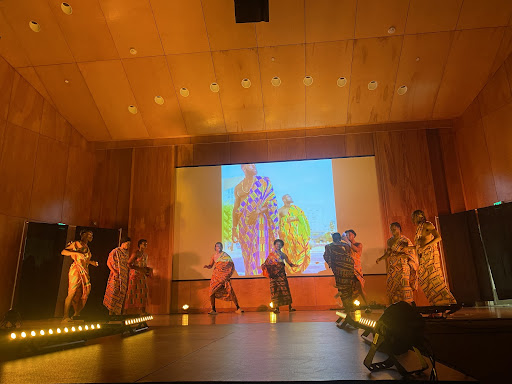
24th Annual ASU Fashion Show Event
By Anthoni Haynes
On March 26th, the African Student Union hosted its extravagant and palatial annual fashion Show in the Student Activities Center its first fashion show hosted by ASU since the Covid-19 pandemic. This year’s fashion show was called SORËË: The Awakening. Soree not to be confused with soiree means “arise” in Twi, a West African language. But indeed, a soiree of melanated proportions it was. The show was made up of various scenes that consisted of vibrant dances, music, and designs. The models and performers were made up of students from African countries like Nigeria, Ghana, Guinea, Mali, etc. in addition to countries in the African diaspora like Haiti, Jamaica, the US, Trinidad & Tobago, Guyana, and the Dominican Republic which genuinely reflected how diverse and grand the Black diaspora is. The designs were a colorful display of garments sewed from African tribal cloth in addition to swim and sweat wear that were designed by local small Black businesses.
Days before the show Black World media was able to get behind-the-scenes footage during one of the show’s rehearsals. The show was run in a storyline setting with the opening scene taking place in a museum. In this scene, five students are exploring a Pan African museum while three of the students looked to be generally fascinated with the exhibit which was models draped in African tribal warrior garments, two of the students were disengaged only taking interest in their phones. The opening scene ends leading into the tribal scene. The tribal scene featured models draped in garments from the Ashanti, Fulani, and other West African tribe. The three tribes then re-enact a war scene in which they battle to the death for a queen. The tribal scene leads into the resplendent wedding scene. In this scene, the groom is the winner of the tribal scene. The groom then dances around his fellow warrior and is then swathed in Kante cloth and bedizened in gold jewelry. The bride was also presented to the audience in a similar opulent, yet feminine fashion. One unforgettable scene was the lavish and blatant “Material Girl” scene. Many of the scenes were choreographed and performed by ASU’s very own La’Afrique Dance team. A swimsuit scene was also featured. A brief intermission followed in which various West African cuisine like kabobs, kelewele, and the dangerously addicting and sweet puff puff, I had the pleasure of indulging in for the first time. After intermission, the E-Board of the African Student union who planned the show also got a chance to walk the stage in their variegated and unique cultural attire.
What was most astonishing about the show was how it unknowingly was a symbol of Pan-African unity in everything from its performers and models to the food that was served during the intermission. Models were not only of first-generation African descent but also of Afro-Caribbean, African American, and Afro-Latinx epitomizing the true diversity of the African diaspora. It was amazing to see young Black men and women embracing themselves, each other, and their culture. worn by to see. This unity was also displayed in the promotion of designs and start-up brands models and cupcakes and cake pops that were served during intermission. It sent the message of how truly powerful and beautiful we are when we come together and as children of Mother Africa, her blood and soul live on through all of us. It was truly beautiful to so many talented and unique Black individuals come together and showcase arts, fashion, and culture in a school in which the Black population is only a mere 6 percent. It exposed to students not just of the Black diaspora but also to students of different ethnic groups the origin of what is the mystical, powerful, diverse, colorful, and grand thing that is Blackness. The 24th annual ASU fashion show was truly a sight to witness, and I can’t wait for its return next year.










